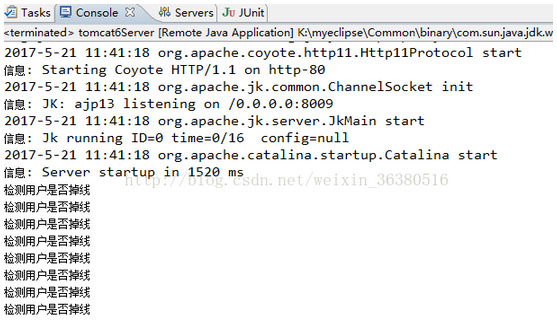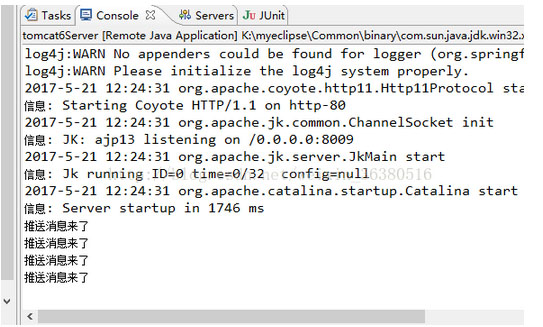前言
在很多實際的web應用中,都有需要定時實現的服務,如每天12點推送個新聞,每隔一個小時提醒用戶休息一下眼睛,隔一段時間檢測用戶是否離線等等。
spring框架提供了對定時器的支持,通過配置文件就可以很好的實現定時器,只需要應用啟動,就自動啟動定時器。下面介紹一下具體做法。
第一種,使用XML配置的方法
前期工作,配置spring的開發環境(這里用到了spring的web應用包,需要導入)
首先創建定時器的任務類,定時器要做什么工作,就在這里寫什么方法。
|
1
2
3
4
5
6
7
8
9
10
11
12
|
package org.time; import java.util.TimerTask; public class MainTask extends TimerTask{ @Override public void run() { System.out.println("檢測用戶是否掉線"); } } |
接著在配置文件中對定時器進行配置。
|
1
2
3
4
5
6
7
8
9
10
11
12
13
14
15
16
17
18
19
20
21
22
23
24
25
26
27
28
|
<?xml version="1.0" encoding="UTF-8"?> <beans xmlns="http://www.springframework.org/schema/beans" xmlns:xsi="http://www.w3.org/2001/XMLSchema-instance" xmlns:p="http://www.springframework.org/schema/p" xsi:schemaLocation="http://www.springframework.org/schema/beans http://www.springframework.org/schema/beans/spring-beans-3.0.xsd"> <bean id="mainTask" class="org.time.MainTask"></bean> <!-- 注冊定時器信息 --> <bean id="springTask" class="org.springframework.scheduling.timer.ScheduledTimerTask"> <!-- 延遲1秒執行首次任務 --> <property name="delay" value="1000"></property> <!-- 每隔2秒執行一次任務 --> <property name="period" value="2000"></property> <!-- 具體執行的任務 --> <property name="timerTask" ref="mainTask"></property> </bean> <!-- 配置任務調度器工廠 --> <bean id="timerFactory" class="org.springframework.scheduling.timer.TimerFactoryBean"> <property name="scheduledTimerTasks"> <list> <ref bean="springTask"/> </list> </property> </bean> </beans> |
最后還需要在web.xml中對配置信息進行注冊:
|
1
2
3
4
5
6
7
8
9
10
11
12
13
14
15
16
17
18
|
<?xml version="1.0" encoding="UTF-8"?> <web-app version="2.5" xmlns="http://java.sun.com/xml/ns/javaee" xmlns:xsi="http://www.w3.org/2001/XMLSchema-instance" xsi:schemaLocation="http://java.sun.com/xml/ns/javaee http://java.sun.com/xml/ns/javaee/web-app_2_5.xsd"> <display-name></display-name> <welcome-file-list> <welcome-file>index.jsp</welcome-file> </welcome-file-list> <listener> <listener-class>org.springframework.web.context.ContextLoaderListener</listener-class> </listener> <context-param> <param-name>contextConfigLocation</param-name> <param-value>/WEB-INF/applicationContext.xml</param-value> </context-param> </web-app> |
這樣就完成了定時器的配置,這時啟動tomcat,觀察控制臺輸出的結果:

第二種,使用注解的形式
(spring中一使用注解,感覺就是比其他方法方便了很多,代碼減少了很多)
這里需要用到AOP,需要引入AOP類庫
先看定時器的任務類:
|
1
2
3
4
5
6
7
8
9
10
11
12
13
|
package org.time; import org.springframework.scheduling.annotation.Scheduled; import org.springframework.stereotype.Component; @Componentpublic class MainTask01{ @Scheduled(cron = "0/3 * * * * ?") public void run() { System.out.println("推送消息來了"); } } |
@Scheduled(cron = "0/3 * * * * ?") 表示三秒推送一次
corn可以配置各種時段任務:
|
字段 |
值 |
特殊表示字符 |
|
年 |
一般為空,1970-2099 |
, - * / |
|
月 |
1-12 或者 JAN-DEC |
, - * / |
|
星期 |
1-7 或者 SUN-SAT |
, - * ? / L C # |
|
日 |
1-31 |
, - * ? / L W C |
|
時 |
0-23 |
, - * / |
|
分 |
0-59 |
, - * / |
|
秒 |
0-59 |
, - * / |
如: 配置每個工作日的10:20觸發 :"0 20 10 ? * MON-FRI"
配置文件:
|
1
2
3
4
5
6
7
8
9
10
11
12
13
14
15
16
17
18
19
20
21
22
23
24
25
26
|
<?xml version="1.0" encoding="UTF-8"?> <beans xmlns:xsi="http://www.w3.org/2001/XMLSchema-instance" xmlns:tx="http://www.springframework.org/schema/tx" xmlns:aop="http://www.springframework.org/schema/aop" xmlns:context="http://www.springframework.org/schema/context" xmlns:task="http://www.springframework.org/schema/task" xmlns="http://www.springframework.org/schema/beans" xsi:schemaLocation="http://www.springframework.org/schema/beans http://www.springframework.org/schema/beans/spring-beans.xsd http://www.springframework.org/schema/tx http://www.springframework.org/schema/tx/spring-tx.xsd http://www.springframework.org/schema/aop http://www.springframework.org/schema/aop/spring-aop.xsd http://www.springframework.org/schema/context http://www.springframework.org/schema/context/spring-context.xsd http://www.springframework.org/schema/task http://www.springframework.org/schema/task/spring-task.xsd"> <context:annotation-config /> <!-- spring掃描注解的配置 --> <context:component-scan base-package="org.time" /> <task:annotation-driven scheduler="qbScheduler" mode="proxy"/> <task:scheduler id="qbScheduler" pool-size="10"/> </beans> |
配置文件的頭部信息中比上一個引入了
|
1
2
3
|
xmlns:task="http://www.springframework.org/schema/task" http://www.springframework.org/schema/task http://www.springframework.org/schema/task/spring-task.xsd |
<task:annotation-driven scheduler="qbScheduler" mode="proxy"/>
<task:scheduler id="qbScheduler" pool-size="10"/>
這兩句配置信息是必須要寫的,這是spring識別@Scheduled注解的關鍵
這這樣簡單的幾句配置之后,開啟服務,運行結果:

spring中使用注解的方法完成定時器,不需要集成其他父類定時器,使用簡單方便!代碼量少,功能也很強大!
總結
以上就是這篇文章的全部內容了,希望本文的內容對大家的學習或者工作能帶來一定的幫助,如果有疑問大家可以留言交流,謝謝大家對服務器之家的支持。
原文鏈接:http://blog.csdn.net/weixin_36380516/article/details/72596834















